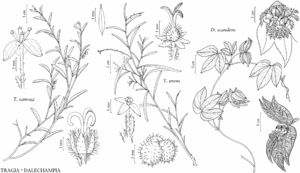Difference between revisions of "Tragia urens"
Sp. Pl. ed. 2, 2: 1391. 1763.
FNA>Volume Importer |
FNA>Volume Importer |
||
| Line 19: | Line 19: | ||
|name=Leptobotrys discolor | |name=Leptobotrys discolor | ||
|authority=Baillon | |authority=Baillon | ||
| − | }}{{Treatment/ID/Synonym | + | }} {{Treatment/ID/Synonym |
|name=Tragia discolor | |name=Tragia discolor | ||
|authority=(Baillon) Müller Arg. | |authority=(Baillon) Müller Arg. | ||
| − | }}{{Treatment/ID/Synonym | + | }} {{Treatment/ID/Synonym |
|name=T. discolor var. linearis | |name=T. discolor var. linearis | ||
|authority=(Michaux) Müller Arg. | |authority=(Michaux) Müller Arg. | ||
| − | }}{{Treatment/ID/Synonym | + | }} {{Treatment/ID/Synonym |
|name=T. discolor var. subovalis | |name=T. discolor var. subovalis | ||
|authority=(Michaux) Müller Arg. | |authority=(Michaux) Müller Arg. | ||
| − | }}{{Treatment/ID/Synonym | + | }} {{Treatment/ID/Synonym |
|name=T. linearifolia | |name=T. linearifolia | ||
|authority=Elliott | |authority=Elliott | ||
| − | }}{{Treatment/ID/Synonym | + | }} {{Treatment/ID/Synonym |
|name=T. urens var. innocua | |name=T. urens var. innocua | ||
|authority=(Walter) Pax & K. Hoffmann | |authority=(Walter) Pax & K. Hoffmann | ||
| − | }}{{Treatment/ID/Synonym | + | }} {{Treatment/ID/Synonym |
|name=T. urens var. lanceolata | |name=T. urens var. lanceolata | ||
|authority=Michaux | |authority=Michaux | ||
| − | }}{{Treatment/ID/Synonym | + | }} {{Treatment/ID/Synonym |
|name=T. urens var. linearis | |name=T. urens var. linearis | ||
|authority=Michaux | |authority=Michaux | ||
| − | }}{{Treatment/ID/Synonym | + | }} {{Treatment/ID/Synonym |
|name=T. urens var. subovalis | |name=T. urens var. subovalis | ||
|authority=Michaux | |authority=Michaux | ||
| Line 58: | Line 58: | ||
|elevation=0–300 m. | |elevation=0–300 m. | ||
|distribution=Ala.;Fla.;Ga.;La.;Miss.;N.C.;S.C.;Tex.;Va. | |distribution=Ala.;Fla.;Ga.;La.;Miss.;N.C.;S.C.;Tex.;Va. | ||
| − | |discussion=<p>Tragia urens is widespread from the Gulf Coast to the mid-Atlantic states and displays considerable foliar variation. Leaf blades that usually are oblanceolate to linear with entire to sinuate margins, two stamens, and sparse, stinging hairs are diagnostic traits for this species.</p> | + | |discussion=<p><i>Tragia urens</i> is widespread from the Gulf Coast to the mid-Atlantic states and displays considerable foliar variation. Leaf blades that usually are oblanceolate to linear with entire to sinuate margins, two stamens, and sparse, stinging hairs are diagnostic traits for this species.</p> |
|tables= | |tables= | ||
|references= | |references= | ||
| Line 82: | Line 82: | ||
|publication year=1763 | |publication year=1763 | ||
|special status=Selected by author to be illustrated;Endemic | |special status=Selected by author to be illustrated;Endemic | ||
| − | |source xml=https://jpend@bitbucket.org/aafc-mbb/fna-data-curation.git/src/ | + | |source xml=https://jpend@bitbucket.org/aafc-mbb/fna-data-curation.git/src/8f726806613d60c220dc4493de13607dd3150896/coarse_grained_fna_xml/V12/V12_901.xml |
|genus=Tragia | |genus=Tragia | ||
|species=Tragia urens | |species=Tragia urens | ||
Revision as of 14:50, 18 September 2019
Herbs or subshrubs, 2–5 dm. Stems erect, green to purple-green, apex never flexuous. Leaves: petiole 0–2 mm; blade usually oblanceolate to linear, sometime elliptic, 2–8(–10) × 0.2–1.4 cm, base acute, margins entire or irregularly and shallowly sinuate, apex acute. Inflorescences terminal (often appearing leaf opposed), glands absent, staminate flowers 3–45 per raceme; staminate bracts 1–1.5 mm. Pedicels: staminate 1.3–2 mm, persistent base 0.3–0.6 mm; pistillate 3.5–4 mm in fruit. Staminate flowers: sepals 4–5, green, 1–1.5 mm; stamens 2, filaments 0.2–0.4 mm. Pistillate flowers: sepals linear, 1–1.8 mm; styles connate 1/4–1/3 length; stigmas undulate. Capsules 7–8 mm wide. Seeds brown with tan streaks, 3–4 mm. 2n = 44.
Phenology: Flowering late spring; fruiting summer–fall.
Habitat: Dry, sandy pinelands, oak barrens, disturbed fields.
Elevation: 0–300 m.
Distribution
Ala., Fla., Ga., La., Miss., N.C., S.C., Tex., Va.
Discussion
Tragia urens is widespread from the Gulf Coast to the mid-Atlantic states and displays considerable foliar variation. Leaf blades that usually are oblanceolate to linear with entire to sinuate margins, two stamens, and sparse, stinging hairs are diagnostic traits for this species.
Selected References
None.
